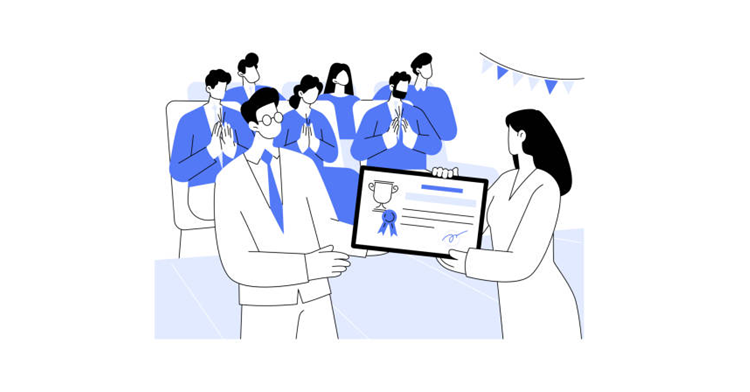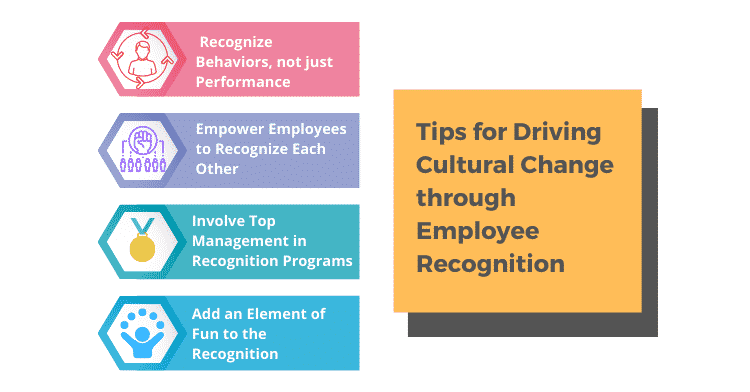1. Recognize Behaviors Alongside Performance: To drive cultural change, organizations should recognize both performance and behaviors that align with core values, encouraging a culture of appreciation and collaboration.
2. Empower Peer-to-Peer Recognition: Allowing employees to recognize each other promotes engagement and reinforces desired behaviors, creating a more inclusive and value-driven culture.
3. Involve Top Management: Top management’s support and active involvement in recognition programs strengthen the importance of culture and values, inspiring employees to align with organizational goals.
4. Make Recognition Fun and Engaging: Adding fun and creative elements to recognition programs can boost employee interest and make cultural change more appealing and practical.
Today, organizations are trying to build a culture and align employee behaviors. However, this is much more challenging than it sounds. An employee recognition program can drive cultural change; let’s examine how organizations can implement it effectively.

Organizational culture refers to the set of social behaviors and activities that employees exhibit.
It is all about the collective experience of employees while interacting and collaborating with their coworkers.
Culture can be best defined as the glue that holds a workplace together by enabling transparent two-way communication, recognition, and feedback.
A good organizational culture can empower employees to express their ideas and opinions freely and feel genuinely valued for their efforts and achievements.

A rewards and recognition program can motivate employees to repeat desirable organizational behaviors.
By recognizing employees who display such behaviors, the organization can send out a strong positive message to the entire workforce.
Additionally, an employee reward program helps establish acceptable workplace behavior among employees.

The employees feel motivated to emulate the performance, efficiency, skills, and behavior of their peers, who have been recognized and rewarded for their outstanding work.
A well-designed employee recognition program can significantly enhance employee happiness and satisfaction, which is crucial for fostering a positive organizational culture.
Steering the organization’s culture in the right direction is an ongoing process as it undergoes many changes.
Hence, by aligning culture with values, business objectives, and recognition programs, organizations can get the desired results faster.
So, here are a few key aspects that organizations need to focus on while trying to drive cultural change through recognition:
1. Recognize Behaviors, not just Performance
2. Empower Employees to Recognize Each Other
3. Involve Top Management in Recognition Programs
4. Add an Element of Fun to the Recognition


To drive cultural change, organizations should encourage supervisors to recognize employees for desired behaviors that align with core values.
Recognizing performance is important, but managers should recognize behavioral aspects as well, not just the outcomes.
Means also matter, not just the ends of driving cultural change.
Simple measures such as a note of appreciation can promote a culture of appreciation and collaboration.
Organizations should encourage managers to reward and appreciate their team members by including them in their key results areas (KRAs).
Implementing an employee rewards platform can help managers reward and recognize instantly through Spot Awards.

Peer-to-peer recognition is an excellent way to empower employees to appreciate their co-workers independently.
Hence, such initiatives help in assuring employees that their opinions are valued, which, in turn, results in better engagement.
Employees are more likely to recognize their peers for behaviors rather than performance.
It utilizes an online employee recognition platform that enables employees to recognize their peers for demonstrating the core values they embody.
Hence, it can help reinforce behaviors that align with the organization’s values and culture.

Implementing any lasting change within an organization requires the complete support and encouragement of the top management.
It is true even when building a culture driven by recognition. Leaders can achieve this by attending offline or virtual award ceremonies.
These forums can drive the importance of values and culture in individual and team achievements.
The involvement of business leaders at various levels and types of employee recognition activities can have a major impact.
Hence, their presence makes it much more effective as employees feel inspired to be part of something significant.

Organizations strive to create a positive and informal work culture, making recognition exciting and fun-filled to capture employee interest.
This can be done through creative employee recognition ideas that are both innovative and fun.
Hence, by incorporating a fun element into employee recognition programs, organizations can inspire employees to adopt cultural change more effectively.
The implementation of an effective employee recognition program can drive cultural changes in an organization over time. Such cultural changes can provide long-term benefits for an organization and fuel business growth.

Lead author: Sagar Chaudhuri, the Co-Founder and CEO of HiFives. He is an HR Tech Evangelist with over 25 years of experience in both corporate and entrepreneurial settings. Previously, Sagar has held leadership roles with companies such as Genpact, Infosys, and ICICI Bank. He has an engineering degree from IIT Kharagpur and an MBA from IIM Lucknow. Connect on LinkedIn
To stay updated on the latest HiFives blogs, follow us on Twitter (@MyHiFives)